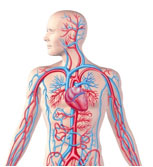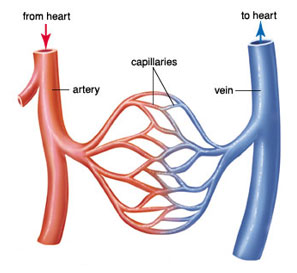
Source: Circulatory System, Interactive Biology

Source: Circulatory System, Interactive Biology
When you think of the circulatory system, you most likely think of blood. The circulatory system transports nutrients and oxygen to all cells in the body as well as carries away wastes. The circulatory system is made up of the heart, blood vessels, and blood.
Blood serves many functions including the following functions:
Blood is carried in the blood vessels. There are three types of blood vessels: arteries, veins, and capillaries. The chart below describes each type of blood vessels.
Arteries |
Veins |
Capillaries |
|
| Structure | Thick, elastic walls | Thinner than arteries | Have only one cell layer thick |
| Function | Carry blood away from the heart | Carry blood back to the heart |
|

Source: Human Heart, Greys Anatomy
In the image to the right, the arteries are shown in red, and the veins are shown in blue. The capillaries connect the arteries and veins.
Many people mistakenly think that all arteries carry oxygen-rich blood and that all veins carry oxygen-poor blood. This is not true. Remember, arteries carry blood away from the heart, and veins carry blood to the heart.
The human heart is about the size of an adult's fist. The heart is a muscular pump that circulates blood. The human heart is divided into four chambers. There are four valves located in the heart. The valves keep blood from flowing backward into the heart.
![]() The animation below shows how blood flows through the heart. Click on "Begin" to learn more.
The animation below shows how blood flows through the heart. Click on "Begin" to learn more.
The main function of the respiratory system is to exchange oxygen and carbon dioxide. Oxygen is used by the body, and carbon dioxide is given off as a waste product. When the human body breathes, it takes in oxygen and exhales carbon dioxide.
![]() The diagram below shows the main parts of the respiratory system. Scroll over each part to learn more.
The diagram below shows the main parts of the respiratory system. Scroll over each part to learn more.